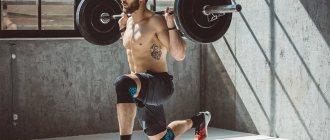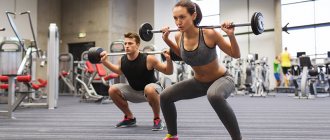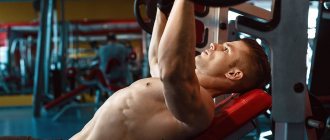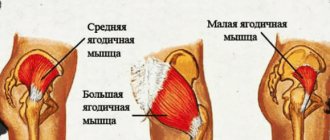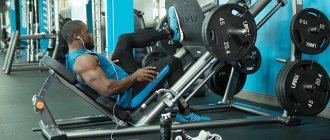- September 19, 2018
- Workouts in the gym
- Marina Semenyuk
For some, the time of training in a sports club is 40-45 minutes, for others – 1-1.5 hours. Are both theories correct? It turns out yes. Now, it remains to find out why.
Duration of strength training in the gym
It is important for a novice bodybuilder to know how long a workout in the gym should last if the emphasis is on mass. This time is about 1-1.5 hours. A professional bodybuilder will spend 40–60 minutes on his workout, since he has a specialized program for pumping a particular muscle group.
For beginners, it is important to remember how long a mass workout should last, since they need a basic groundwork. For beginning athletes, there is no strict restriction on rest between exercises and approaches.
If strength training exceeds the maximum limit, cortisol begins to be produced, which destroys muscle tissue. Increased physical activity will lead to overstrain of the body and unpleasant consequences. In any case, you need to understand that you should visit the gym regularly. There will be more benefit from 12 lessons than from 4.
How long do interval training last?
The intensity of the activity plays an important role here. “For a HIIT workout, time recommendations depend on the intensity, so, for example, a Tabata workout can last 15 minutes without taking into account the warm-up and cool-down. On average, such training can last from 30 to 60 minutes,” says Anastasia Yurkova.
If we are talking about LIIT - low intensity interval training - it can last 60-75 minutes. Because the lesson takes place at a fairly low heart rate.
Duration of fat burning session
A significant role in the fitness process is played by the problem of how long a workout in the gym should last when you want to start the fat burning process. The minimum load should last at least 30 minutes. It is after this time that the acceleration of metabolism and the fat burning mechanism are triggered.
The best option is to train in cardio mode for about 45–60 minutes, taking into account the warm-up and final complex. Experienced trainers do not advise exercising for more than an hour, since along with fat loss, muscle mass also goes away.
A high-intensity session typically lasts 20–25 minutes.
How long should a home workout last?
The duration of training at home is not particularly different from training in the gym; it all depends on the availability of a sufficient amount and weight of equipment.
- Home workouts should include all stages of training, just like in the gym.
- The main part will also depend on the goals: when gaining weight, 45-60 minutes is enough, training for weight loss can last an hour and a half if it includes both strength and cardio exercise.
- Outdoor cardio training should also not exceed more than 1 hour, while two hours will be enough for walking.
Number of visits to the gym to gain weight and lose weight
It is important how long a workout in the gym should last, and how often you visit a sports club. If a bodybuilder trains twice a week, he should be working at full capacity. If a visitor to a sports club is a regular visitor, then the load needs to be distributed evenly.
If the goal is to lose weight, then classes should be held 3-4 times a week. In this case, the fat layer is burned, the muscles do not lose their shape. This regimen helps improve your mood and reduce fatigue.
To increase muscle mass, the best option (for both beginners and professionals) is to visit the gym 2-3 times a week. With this schedule, physical activity is regular. The muscles have time to recover, which leads to the goal.
Aerobic training: optimal duration
This type of exercise is designed to burn fat deposits, so the duration of each should not be less than 30 minutes. During the first 20 minutes, the body uses carbohydrates and, only after exhausting their reserves, is “mistaken” for fats. Therefore, 15-minute workouts, even with regular and frequent repetition, will not bring the desired result - the weight will stand still for the above physiological reasons.
But do not forget about the upper limit of the duration of aerobic training. If classes last more than 45-60 minutes, then along with body fat you will begin to lose muscle mass - and this is not always the desired effect of training.
If you are just starting to exercise, then at first it is better to deliberately reduce the duration of aerobic training. Our body needs to get used to the loads - only by gradually increasing them, we can not be afraid of unpleasant consequences such as muscle pain or even injuries. Of course, it all depends on individual characteristics, but in most cases, experts recommend that beginners spend 15–20 minutes training 3 times a week, and increase the load no earlier than after 2 weeks.
Optimal time to visit
Strength training is recommended to be done in the afternoon. The following facts support this:
- Testosterone is required for muscle growth. It is produced in the evening, so when gaining weight, this will be the best option.
- Cortisol levels, on the contrary, decrease in the afternoon. This has a positive effect on the growth of muscle mass and increased strength.
- By evening, most people's temperature rises slightly. This promotes rapid recovery of muscle fibers after high-quality strength training.
- Throughout the day, the body gradually warms up and by evening is ready for strength training.
However, early risers should exercise in the morning. This way they can achieve better results. In principle, the training regime in a sports club should be selected individually for each person. It is recommended to give the body 1 hour of rest before strength training.
Consequences of overexertion
It is important to remember how long strength training should last for it to be beneficial and not harmful. Excessive loads lead to disastrous consequences.
- The condition of the muscles is deteriorating. If a workout lasts more than 60 minutes, the body produces the hormone cortisol. The source of energy is amino acids necessary for the “building” of muscle tissue. Doing the exercise for too long leads to poor health and a decrease in overall tone. As a result, a sporty and proportional silhouette of the figure is not formed.
- Muscles may not receive enough oxygen. Excessive exercise leads to the fact that nutrients do not reach all tissues of the body. Long training disrupts breathing, and this leads to accelerated muscle aging.
- The key to a high-quality and effective workout is the selection of weights, the number of repetitions of specific exercises, and the frequency of visiting the gym.
Overtraining as a consequence of excessive load leads to the following consequences:
- nausea;
- dizziness;
- increase in temperature;
- loss of strength;
- sore throat;
- sudden changes in pressure.
Rules for effective training
- Intervals between approaches. During gym classes, it is unacceptable to flirt with the opposite sex, talk on the phone, or take pictures of yourself in the mirror between sets. An ill-conceived training process will not bring any results. The optimal rest time between sets is 2 minutes. After this time, you should begin either a new exercise or a subsequent repetition of the previous one. Thus, the time spent in the gym is reduced from 3 hours to one.
- Number of exercises in one workout. First you need to draw up a plan that will indicate exercises for a specific day. A common mistake is trying to load the whole body. In one workout, it is important to identify the muscle group that needs to be worked on and perform the exercise efficiently.
- Experience. Beginners in sports need to understand how prepared their body is for heavy loads. You can’t look up to a professional bodybuilder whose entire workout comes down to 45 minutes. But his load is on a specific muscle group and with enormous loads. If a beginner starts doing a similar exercise with the same weight, this may be his last session. Loads should increase gradually.
- Well-being. The work schedule plays a role here. If you go to the gym or work out at home with weights after work, you can soon expect muscle failure. To prevent this from happening, the training time is reduced. It is best to visit a sports club after relaxing.
- Preparation of split training. This affects which exercises will be performed, in what number of repetitions and sets, and also clearly outlines how long a workout should last in the gym. Time is rationally distributed, the final result is high quality.
How long should the workout last?
People who work out in the gym often apply the principle “the longer the session lasts, the faster the result will be seen.”
And this is logical, because in order to achieve success, you need to work long and persistently.
But in the gym, this principle does not work, and often gives the opposite effect - instead of an increase in results, there is a complete absence of them. Or even worse, productivity drops and overtraining develops.
To avoid such negative consequences, you need to know how long the training should last.
The duration of the workout differs depending on the goal:
- When gaining muscle mass
The optimal duration is from 40-50 minutes to 60-90 minutes.
The first time interval is more suitable for ectomorphs, who are contraindicated for long workouts that take a lot of energy.
For mesomorphs and endomorphs, classes of 60-90 minutes are more suitable.
Read about how to determine your body type here.
- When working for strength
Strength development involves fewer exercises and repetitions than when working on muscle mass.
However, their average duration is 1.5-2 hours.
This is explained by the maximum weight on the equipment, and, accordingly, the need to recover longer between approaches.
- When working on relief (weight loss)
Training for weight loss in the gym has its own characteristics. Two components are required here - strength training and cardio.
The duration of the power load is 40-60 minutes.
At the same time, the occupational density is very high. Exercises are performed with minimal rest between sets (30-45 seconds), or without rest at all (circuit training).
After the strength part there is a cardio load lasting 30-60 minutes, depending on the level of training.
In total, terrain training takes 1-2 hours.
SUMMARY:
The optimal duration of a training session, if you are not a professional athlete, is from 30 to 120 minutes.
During this time, you will definitely have time to work out all muscle groups.
If you exercise at high intensity for more than 2 hours, you risk overtraining due to the heavy load.
Conversely, low-intensity training using long periods greatly reduces the positive effects of training.
Basic exercises in the gym
It is important not only how much time you need to work out in the gym, but also how to correctly design your training regimen. Basic exercises are considered the basis for increasing muscle mass. They are present in almost all training programs. It should be remembered that not all basic exercises are capable of “pumping up” more than 2 muscle groups. However, they all help achieve the goal.
The following basic exercises are distinguished:
- on the back;
- on the pectoral muscles;
- on shoulders;
- on the biceps;
- for triceps;
- on your feet.
The following exercises have the greatest effect on muscle growth:
- two types of bench press: standing and lying;
- squats;
- two types of deadlifts: deadlifts and bent-over barbells.
Deadlift
To the question of how long a workout in the gym lasts, you need to add the question of what to include in the schedule. Deadlifts are ideal for working all the core muscles. It is she who involves maximum muscles in the training process.
The first rule of deadlifting is minimal weight. The use of a stand is also considered important. If you lift the barbell “from the ground,” you will have to break your technique, since your hips do not remain tense all the time, and it is impossible to keep your back perfectly straight.
How to exercise correctly and often to lose weight
The frequency of training when burning fat mass is subject to a slightly different law than the frequency for muscle growth. To lose fat and gain definition, you can train every day, the main thing is to prevent the development of overtraining. High frequency of training dictates the need to use anti-catabolic drugs to protect muscle tissue from destruction. In this case, bodybuilders are recommended to reduce the number of strength training sessions to 2 per week, and devote the rest of the time to aerobic training.
How to Avoid Overtraining
To avoid overtraining and find your optimal training frequency, you need to closely monitor the progress you make with each exercise in the program. Look for any signs of slowing or stalling progress. Lack of change in one exercise is a warning sign. And the lack of progress in two or more exercises is a danger signal, which means you need to rest a little.
3 signs of overtraining and how to solve them
- The weight used in each exercise does not increase
- Strength training is primarily about progressive overload. This means you should return to the gym fully recovered and lift slightly heavier weights than you lifted during your last workout.
- The number of repetitions or static hold time in each exercise does not increase
If your exercise weight has not increased (see above), then the number of repetitions or static hold time should increase. Recent research shows that increasing the duration of a static hold to 12 seconds produces less benefit than increasing the weight with a shorter hold time.
Taking sports supplements - creatine, arginine, intra-workout, bcaa amino acid and pre-workout complexes will help you increase your strength. These sports nutrition products are specifically formulated to improve performance in sports and fitness for men and women. Just add it to your diet and go ahead to conquer new heights!
Squats with weights
To increase leg muscles, squats with a barbell are considered ideal. This exercise works all muscle groups of the lower body: buttocks, quadriceps, calves. Professional athletes rarely perform “abs” complexes. When doing squats with weights correctly, the treasured cubes appear.
For beginners in the sports club there is a special frame. It is designed to teach proper squatting technique with a light weight, but the leg muscles are worked as much as possible. Initially, the buttocks are pushed up and the knee joints are straightened.
Barbell row to the waist
You can visually expand your back muscles with this exercise. If the execution technique is correct, then the deltoid and pectoral muscles work. To learn this exercise, a special simulator will come to the rescue, where first the weight is pulled to the knees, and later almost to the chest. At the same time, the shoulder blades are reduced. At the moment when the weight is pulled to the chest, the athlete feels tension in the latissimus dorsi muscles.
Is it important how much you need to work out in the gym? Yes, sure. But you need to remember about a well-designed schedule, selected training times and the frequency of visiting the sports club. Only the relationship of these components can lead to the best result.


